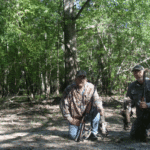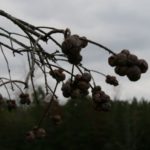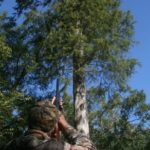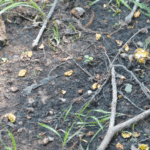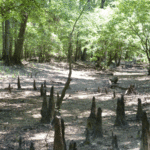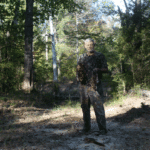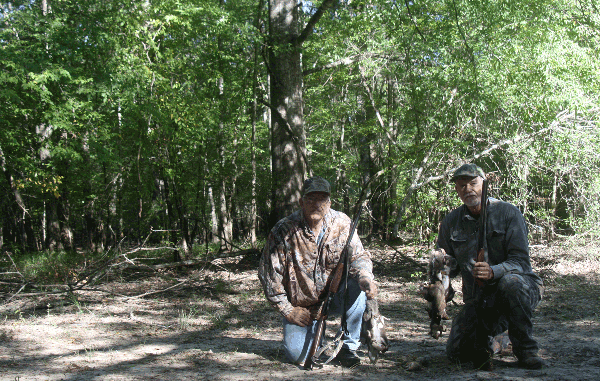
Cypress trees provide not only an alternate food source for bushytails, but they offer hunters easy opening-weekend limits — without all the hunting pressure.
Traditionally, Louisiana’s hunting season kicks off in earnest at the crack of dawn on the first Saturday of October when a veritable army of camouflaged hunters creep into the woods in search of fox and cat squirrels.
The vast majority of those hunters target groves of mast-bearing oak trees, while some will slip through mixed pine and oak forests.
But a few nonconformists will head in a completely different direction — and very likely shoot their limit of bushytails.
Cypress trees are one of the most-overlooked places to hunt because many hunters are not even aware of how heavily squirrels feed on cypress balls in the early fall.
I have to admit I didn’t know it until one October morning when I was easing down a slough in Dugdemona swamp with my Marlin bolt-action .22 rifle.
The weather had been particularly dry, and trying to stalk in the woods was like walking across potato chips. As a result, I chose to hunt in the dry slough bed — not because I had killed a lot of squirrels there, but simply because its damp soil made for quieter walking.
About an hour after sunup, I was standing under a cypress tree when I heard a squirrel squeal nearby. I’m hard of hearing and quickly got frustrated trying to pin point where the bushy tail was located.
Each time I turned my head, it seemed like the squirrel was in a new location. Then it dawned on me that he was directly overhead.
I had to slowly back up about 20 yards to get a good view of the cypress tree. Each time the squirrel squealed I scanned the branches carefully and finally saw his twitching tail.
Taking a rest on a mayhaw tree, I settled the crosshairs on his head and knocked him out with one shot.
Early in my hunting career, I learned to stay put after shooting a squirrel because others are likely to be nearby and will resume feeding within a few minutes. This is particularly true during the first week of the season when they are not yet gun shy.
Sure enough, within a minute I saw another squirrel in the cypress tree and shot him out. Then another one moved high up on the trunk.
I quietly eased around to where I could see him better and shot him, too.
Then a fourth one came scurrying down the trunk, chattering away at me. After shooting him, I stood still for about five more minutes, and then popped a fifth one.
In about 20 minutes, I had bagged five cat squirrels out of one tree, and every one of them was stuffed with cypress balls.
“Hmmm,” I thought, “I might be on to something.”
Ever since that morning, I have always hunted along sloughs or Dugdemona River on opening day and during the first week or so of the season. And I probably shoot more squirrels out of cypress trees than oak, pine and hickory combined.
Hunting the cypress trees found along sloughs and small creeks offers a couple of advantages early in the season.
For one thing, on those frustratingly dry days when you can’t take a step without sounding like an elephant in the woods, you can usually stay a lot quieter easing along a slough or creek bed. The ground is often somewhat damp, and there’s not as many leaves, sticks and other debris to step on.
There are also fewer trees and brush in a slough bed, which makes for a more-open canopy and a longer field of view. That helps in spotting squirrels at a distance, and the open woods are perfect for a .22 if you happen to enjoy that challenge.
Since squirrels frequently den in cypress trees, it’s not unusual to find several in one tree or in close proximity. More often than not, these groups are young squirrels that are not yet woods wise.
In the first few days of the season, even a shotgun blast often does not alarm them.
However, my experience has been that not all cypress trees are equal when it comes to holding feeding squirrels. Some people make the mistake of staking out a large hollow tree in hopes of bushwhacking squirrels traveling back and forth from their den. They may bag one occasionally, but as a rule the large, ancient cypress trees do not produce as many cypress balls as the small to medium sized ones.
And it’s the cypress balls that attract squirrels from other den trees farther out in the woods.
On last year’s opening day, I discovered that cypress trees hold squirrels early in the season even when there are few cypress balls. That morning, my brother Danny and I headed into Dugdemona swamp to see if we could find some cypress-tree squirrels. Parking on a small pipeline, I headed down a slough bed on one side of the line while he disappeared in the other direction.
On that particular morning, I was carrying my favorite squirrel gun — a 20-gauge Spartan double-barrel shooting 3-inch No. 5’s in a full choke. I covered about 200 yards during the first 20 minutes or so of shooting light, but didn’t see a thing.
Every time I passed a cypress tree I checked the ground for cuttings but saw very little. It had been one of the hottest, driest summers on record and obviously there had not been much of a cypress ball crop.
This year, I thought, might be a bust.
Then out of nowhere, a cat squirrel came out of a cypress tree right in the middle of the slough and scampered across a limb, heading for the hardwood timber. The slough’s bank was steep, and I had a hard time keeping him in sight while I made my way to the top.
But I soon saw the squirrel had joined another one in running from tree to tree, but they wouldn’t stop to feed. Rather than chase after them, I just stood in place and the first one eventually made his way back to the cypress tree and I shot him out.
I watched the woods for a while but never saw the other squirrel and resumed my walk down the slough bed. I hadn’t gone far when another squirrel bailed out of a cypress tree and headed for the oak trees.
A quick snap shot with my Spartan brought him down.
None of the cypress trees I checked out had much evidence of feeding squirrels, but nearly all of the squirrels I saw that morning were either coming out of cypress trees heading to the hardwoods or running through the cypress to cross from one side of the slough to the other.
Finally, later in the morning, I found a nice group of squirrels. One ran out of a cypress tree and into a pin oak, closely followed by another. While easing up to them, a third squirrel bolted out of a tree right over my head and took off toward the others.
None seemed to be spooked, so I thought with a little patience I should be able to get at least a couple of them. But as I watched the squirrels feed just out of shotgun range, a red-tailed hawk soared into a tree about 30 yards away. The hawk never made a sound, but it was as if the squirrels disappeared into thin air.
I stood there for 20 minutes, long after the hawk flew off, but never caught a glimpse of them again.
By then it was nearly time to meet Danny, so I decided to follow Dugdemona back toward the truck. I was just walking along, not really hunting, and was a bit surprised to see a squirrel scurry down a big cypress den tree up ahead in a bend of the creek.
I was watching him closely to see where he was going when two more bailed out of a small cypress not 20 yards in front of me and jumped onto a sweet gum.
I shot one, and then stood ready in case the other one made a run for it. When he did, I cut loose with my other barrel and knocked him out of the tree, but he skittered across the ground with his tail held high.
Quickly reloading, I managed to get him just as he reached the base of a large pin oak. Those two squirrels made six in my game vest, all but two of which had been in the cypress trees.
When I got back to the truck, I found that Danny had killed four squirrels on his side of the pipeline. The dry conditions had made for a tough morning, and we noticed there wasn’t nearly as much shooting in the swamp as on most opening days. Talking to other hunters later, I learned that we had enjoyed better luck than most.
My streak of successful opening-morning hunts in the cypress trees had held.
